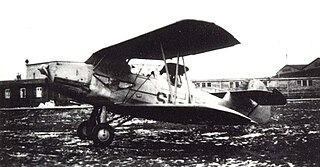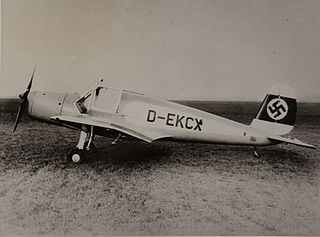| Arado Ar 77 | |
|---|---|
 | |
| Role | Trainer |
| National origin | German |
| Manufacturer | Arado Flugzeugwerke |
| First flight | 1934 |
| Number built | 2 [1] |
The Arado Ar 77 was a German twin-engined monoplane, designed as an advanced training aircraft from 1934.
| Arado Ar 77 | |
|---|---|
 | |
| Role | Trainer |
| National origin | German |
| Manufacturer | Arado Flugzeugwerke |
| First flight | 1934 |
| Number built | 2 [1] |
The Arado Ar 77 was a German twin-engined monoplane, designed as an advanced training aircraft from 1934.
The Ar 77 had a thick cantilevered wooden wing, which was skinned with plywood on the undersurfaces and covered with fabric on the upper surfaces. The fuselage was built up from welded steel tubing covered with fabric. Tail surfaces were built up from steel tubing and were also fabric-covered, not following Arado's trademark layout of a fin and rudder forward of the tailplane. Instead the tailplane was high-mounted on the fin and supported by steel tube 'N' struts. Elevators and rudder were covered with fabric, aerodynamically balanced in the Ar 77A and without aerodynamic balance horns in the Ar 77B. The fixed tailwheel undercarriage consisted of cantilevered oleo-pneumatic main leg struts fitted with brakes and a tailwheel under the rear fuselage. The four crew members, being pilot, navigator or instructor, and two students, were accommodated in a cabin with full-length windows along the fuselage sides. [2]
The Arado Ar 77 was characterised by the relatively low placement of its engines in relationship to the wings. There was room for two people in the cockpit, and four other people, such as radio operators, in the fuselage. However, the Luftwaffe criticized the aircraft, instead, preferring the Focke-Wulf Fw 58.
Data from: [1]
Data from Die Deutsche Luftrüstung 1933–1945, [2] Flugzeug-Typenbuch 1944 [3]
General characteristics
Performance

The Focke-Wulf Fw 58 Weihe (Harrier) was a German aircraft, built to fill a request by the Luftwaffe for a multi-role aircraft, to be used as an advanced trainer for pilots, gunners and radio operators.

The Dornier Do 12 Libelle III was the third of a line of small German flying boats of the 1930s. It started with the Dornier A Libelle I and the Dornier A Libelle II, though the Do 12 was not a continuation, but an entirely new aircraft.

The Arado Ar 67 was the single-seat biplane fighter successor to the Ar 65.

The Arado Ar 66 was a single-engined twin-seat training biplane designed and produced by the German aircraft manufacturer Arado. It was the last aircraft to be designed by the aeronautical engineer Walter Rethel in collaboration with Arado.

The Dornier Do 214 was a proposed large long-range flying boat, developed by Dornier in World War II.

The Heinkel He 72 Kadett (Cadet) was a German single-engine biplane trainer of the 1930s. It was known to its pilots as the Zitterrochen as it shook madly.

The Focke-Wulf Fw 56 Stösser was a single-engine, parasol monoplane advanced trainer, built in the 1930s in Germany.

The Albatros Al 101 was a 1930s German trainer aircraft. It was a parasol-wing monoplane of conventional configuration, and seated the pilot and instructor in separate, open cockpits.

The Arado Ar 76 was a German aircraft of the 1930s, designed as a light fighter with a secondary role as an advanced trainer in mind.

After the success of the 1940 airborne assaults involving the DFS 230, the Reichsluftfahrtministerium invited the Deutsche Forschungsanstalt für Segelflug/DFS and Gotha to submit plans for a larger capacity glider. The result was the DFS 231, a twenty-seat troop designed by Hans Jacobs, who had previously produced the successful, nine seat DFS 230.

The Arado Ar 79 was an aerobatic two-seat trainer and touring aircraft designed and produced by the German aircraft manufacturer Arado. It was the final civilian aircraft developed by the company.

The Heinkel HD 42 50, later designated the Heinkel He 42 was a German two-seat biplane seaplane originally designed for the Deutsche Verkehrsfliegerschule, and later built for the German Luftwaffe. The aircraft was used until the end of World War II as a trainer for maritime pilots.

The Siebel Fh 104 Hallore was a small German twin-engined transport, communications and liaison aircraft built by Siebel.

The Ago Ao 192 Kurier (Courier) was a small German twin-engined aircraft designed and built by AGO Flugzeugwerke in the 1930s. A small production run of six aircraft followed three prototypes, these being used as transports.
The Arado Ar 69 was a two-seat German beginner's school and sport biplane with an open cockpit, developed in 1933 by Arado Flugzeugwerke.

The Fieseler Fi 99 Jungtiger was a German sports aircraft prototype, produced by Fieseler company. The aircraft was a low-wing two-seat aircraft with an enclosed cabin. It was powered by a Hirth HM 506A engine, producing 160 hp (119 kW).

The Albatros L102 / Albatros Al 102, was a German trainer aircraft of the 1930s. It was a parasol-wing landplane, seating the student pilot and instructor in separate, open cockpits. A biplane floatplane version was also built as the Al 102W, with strut-braced lower wings.
The Albatros L 103 / Albatros Al 103 was a German experimental aircraft of the 1930s. It was a parasol-wing landplane of conventional configuration, seating the pilot and flight test observer in separate, open cockpits. The Al 103 was used to test variations in sweepback, dihedral and tailplane area.
The Arado E.583 was a project design from 1945 for a jet-powered night fighter aircraft of the German manufacturer Arado Flugzeugwerke.
The Hirth HM 501 was a 6-cylinder air-cooled inverted in-line engine that was developed by Hirth Motoren GmbH in the late 1930s, from the 4-cylinder HM 500 and used principally on the submarine-born Arado Ar 231.